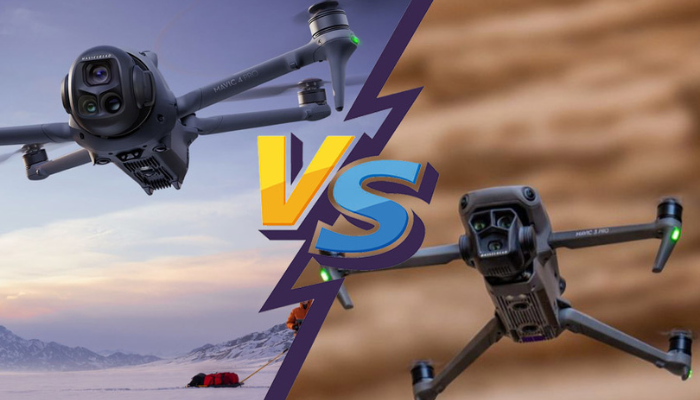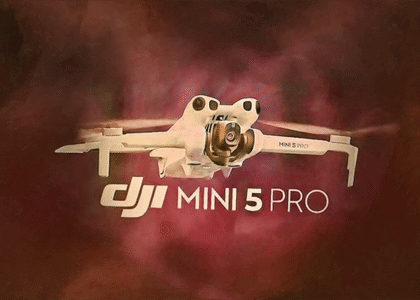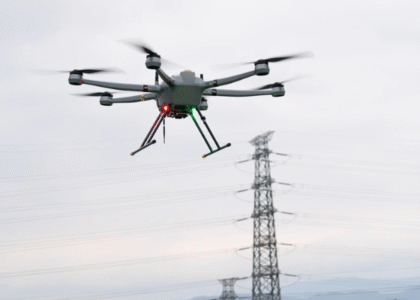You want razor‑sharp images, rock‑solid flight performance, and cutting‑edge safety, all in a portable package. Choosing the right drone can feel overwhelming. Whether you’re a cinematographer capturing aerial scenes, a surveyor mapping complex terrain, or an e‑commerce business showcasing property listings, the decision between the Mavic 4 Pro and Mavic 3 Pro could make or break your project.
1. Camera Systems: Resolution & Versatility
With five times the megapixels, the Mavic 4 Pro’s 100 MP sensor unlocks extraordinary detail, crucial for large‑format prints or detailed GIS mapping. Yet the Mavic 3 Pro’s 20 MP Hasselblad remains a versatile workhorse for most professional tasks.
Main Sensors
- Mavic 4 Pro: 4/3″ CMOS Hasselblad sensor, 100 MP, adjustable aperture f/2.0–f/11, 6K/60 fps HDR video
- Mavic 3 Pro: 4/3″ CMOS Hasselblad sensor, 20 MP, adjustable aperture f/2.8–f/11, 5.1K/50 fps video
Telephoto & Medium Tele
- Mavic 4 Pro: 50 MP telephoto (1/1.5″), 48 MP medium tele (1/1.3″)
- Mavic 3 Pro: 12 MP telephoto (1/2″), 48 MP medium tele (1/1.3″)
The upgraded 50 MP long‑range lens on the Mavic 4 Pro delivers crisper close‑ups ideal for wildlife surveys or industrial inspections while both models share a high‑resolution medium telephoto for consistent framing.
2. Video Performance & Formats
| Feature | Mavic 4 Pro | Mavic 3 Pro |
| Max Resolution | 6K/60 fps HDR, 4K/120 fps | 5.1K/50 fps, 4K/120 fps |
| Bitrate | H.264–90 Mbps, H.265–180 Mbps, ALL‑I up to 1200 Mbps* | ProRes 422 HQ up to 3772 Mbps (Cine) |
| Colour Profiles | 10‑bit D‑Log M/HLG, Hasselblad NCS | 10‑bit D‑Log M/HLG (Cine), 8‑bit standard |
| RAW Video Stacking | Yes | No |
*Only Creator Combo supports ALL‑I encoding.
For high‑end filmmakers, the ALL‑I encoding on the Mavic 4 Pro’s Creator Combo offers intra‑frame compression akin to ProRes, making color grading smoother. Meanwhile, the Mavic 3 Pro Cine’s ProRes options remain a gold standard in professional pipelines.
3. Gimbal & Tracking Innovations
The Mavic 4 Pro’s Infinity Gimbal shatters creative limits, enabling fluid transitions and architectural upward shots without complex rigs.
Infinity Gimbal vs. Standard Gimbal
- Mavic 4 Pro Infinity Gimbal: 360° rotation, 70° upward tilt, full‑roll Dutch angles
- Mavic 3 Pro Gimbal: 3‑axis tilt/roll/pan, 35° upward tilt
Intelligent Tracking
- Mavic 4 Pro: ActiveTrack 360°, Subject Focusing, improved low‑light accuracy
- Mavic 3 Pro: ActiveTrack, Spotlight, POI modes
Subject focusing on the Mavic 4 Pro locks targets across zoom ranges, vital for automotive filming or critical inspection tasks in industries like energy and infrastructure.
4. Flight Performance & Safety
Flight time, range, and obstacle sensing are critical for operational reliability, especially in commercial environments where downtime equals lost revenue.
Endurance & Range
- Mavic 4 Pro: Up to 51 min flight time, O4+ transmission up to 30 km (FCC)
- Mavic 3 Pro: Up to 43 min, O3+ transmission up to 15 km (FCC)
An extra eight minutes can mean capturing the perfect B‑roll shot without returning to base.
Obstacle Sensing & RTH
- Mavic 4 Pro: Omnidirectional 0.1 Lux Nightscape with LiDAR, Non‑GPS RTH, Nighttime RTH mode
- Mavic 3 Pro: Standard omnidirectional sensors, GPS‑based RTH
Low‑light LiDAR sensing makes the Mavic 4 Pro uniquely capable for dusk or dawn operations in construction or event coverage.
Compared to the Mavic 3 Pro’s capable but older O3+ system, the newer innovations in the Mavic 4 Pro offer a significant upgrade for professionals prioritizing safety and operational confidence, especially when flying in complex or unpredictable environments.
5. Controller & Ecosystem
| Controller | Mavic 4 Pro | Mavic 3 Pro |
| Standard | DJI RC 2 (5.5″ screen) | DJI RC (5.5″, 700 nits) |
| Pro Option | DJI RC Pro 2 (7″, 2000 nits) | DJI RC Pro (5.5″, 1000 nits) |
| Integrated Mic | Yes (Pro 2) | Yes (RC Pro) |
| Simulator | Yes | No |
The RC Pro 2’s ultra‑bright display and onboard simulator streamline training sessions, perfect for organizations certifying new pilots under DGCA guidelines.
Conclusion
After a detailed comparison across imaging, video capabilities, motion control, endurance, and safety, it’s clear that the Mavic 4 Pro represents DJI’s most ambitious leap forward—delivering unmatched 100 MP stills, 6K/60 fps ALL‑I video, an Infinity Gimbal for creative freedom, and advanced low‑light LiDAR sensing that extends mission possibilities into dusk and dawn. Yet the Mavic 3 Pro, with its proven 20 MP Hasselblad camera, Cine ProRes workflows, and reliable O3+ link, continues to offer exceptional value for professionals who need consistent performance and streamlined file management in demanding environments.
Whether you’re a real estate marketer in Mumbai seeking hyper‑detailed property imagery, a GIS surveyor in Rajasthan mapping challenging terrain after sunset, or a filmmaker in Delhi crafting corporate narratives, the right drone will accelerate your workflow and enhance your output. That’s where FlyandTech comes in. As India’s leading DJI partner, we not only stock the full range of Mavic drones and accessories but also provide comprehensive, an instructor‑led training program to both beginners and seasoned pilots and ongoing technical support.
Frequently Asked Questions
1. Which drone is better for low‑light aerial photography?
A. The Mavic 4 Pro’s Dual‑Native ISO Fusion and Nightscape LiDAR sensing give it a clear edge in low‑light and nighttime operations.
2. Can I use the Mavic 4 Pro for professional mapping projects?
A. Absolutely, it’s 100 MP sensor and LiDAR‑enhanced RTH make it ideal for high‑precision surveying and GIS workflows.
3. Is the Mavic 3 Pro still worth buying in 2025?
A. Yes. For professionals on a budget or those who value proven reliability, the Mavic 3 Pro Cine remains a versatile, industry‑trusted option.







